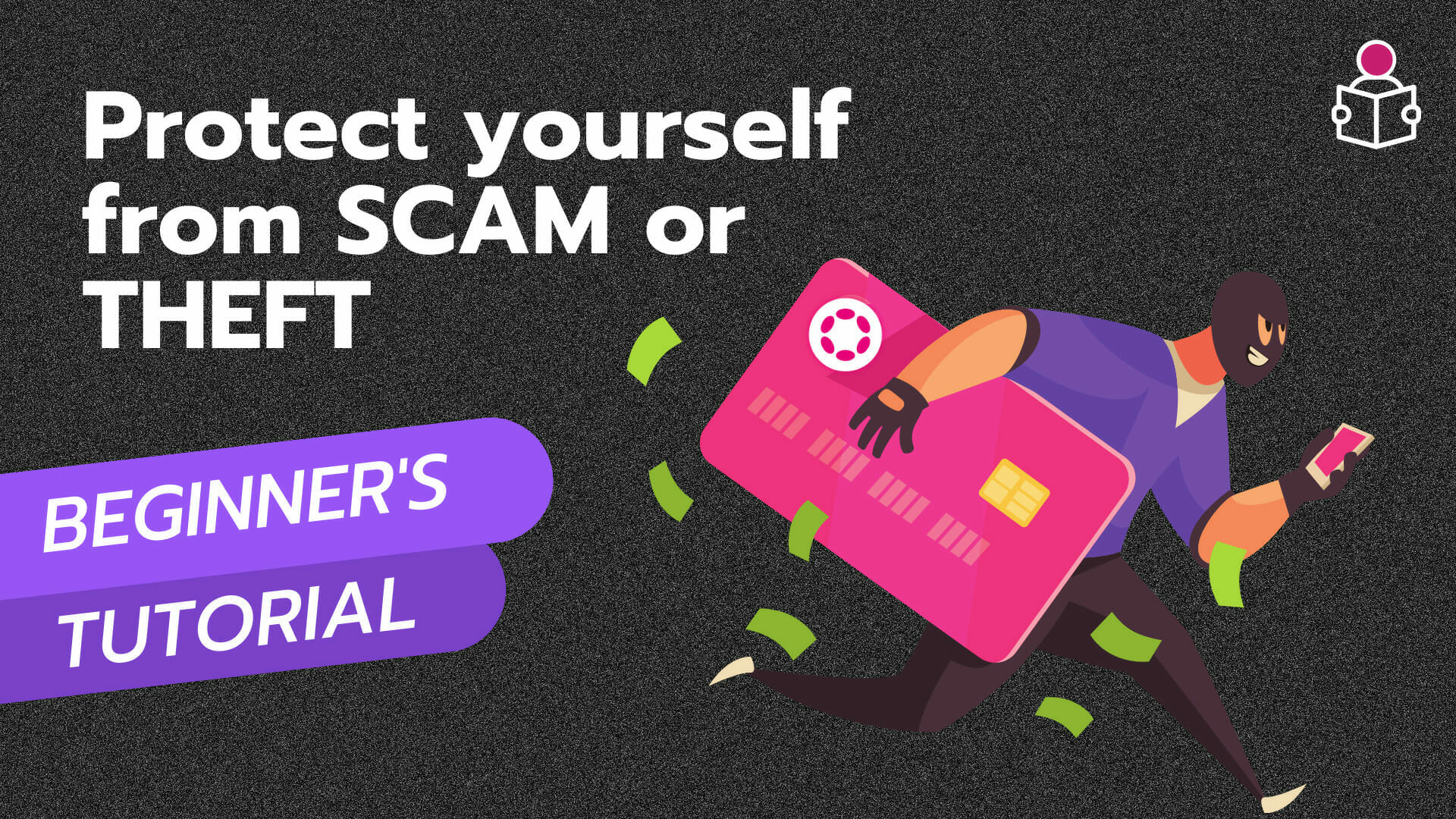Welcome to our comprehensive guide on how to safeguard yourself from scams within the Polkadot Ecosystem. In this Blog post, we will discuss various types of scams prevalent in the crypto industry and provide you with essential tips and examples to help you stay protected. It’s important to be informed and proactive in today’s digital world to ensure the safety of your investments and personal information. Let’s dive in!
Table of Contents
- Be Aware of Scams on Social Media Platforms
- Never Share Your Seed Phrase
- Avoid Trusting Online Claims
- Transaction Reversals and Scam Attempts
- Beware of Unrealistic Offers and Giveaways
- Recognising Direct Message Scams
- Phishing Attacks and Suspicious Websites
- Official Channels and Verification
- Research Projects and Teams
- Use Secure Wallets
- Stay Updated on Security Measures
- Report Scams and Suspicious Activities
- Conclusion
- FAQ’s (Frequently Asked Questions)
- I have been scammed, what should I do?
Be Aware of Scams on Social Media Platforms
The crypto industry is rife with scams, whether they are found in Telegram groups, Instagram channels, or even on platforms like Twitter and Facebook. Scammers often claim to be part of official groups or project admins, leading unsuspecting users into their traps. Stay vigilant on any platform you use, including social media, and exercise caution.
Never Share Your Seed Phrase
Your seed phrase is a master key that grants access to your accounts and sub-accounts, allowing funds to be transferred without your knowledge. Never share your seed phrase with anyone, as scammers may try to trick you into revealing it through various means. Also known as raw seed, mnemonic seed, secret key, or private key, keep this information confidential at all times.
Avoid Trusting Online Claims
Exercise caution when dealing with individuals who claim to be part of the official blockchain network and request access to your device. Scammers may create fake websites or personal portals, deceive you into logging in, and gain control over your account or engage in illegal activities using your account information. Be skeptical and verify the authenticity of all communication channels.
Transaction Reversals and Scam Attempts
It’s crucial to understand that once a transaction is completed, it cannot be reversed. Scammers may convince you that previous transactions did not register and request additional funds, promising to revert the original transaction within 1-2 days. This is a common scam technique. While Polkadot Network has provisions for governance referendums and on-chain voting to potentially revert transactions, proving your innocence or the legitimacy of the request can be challenging. Always exercise caution when transferring funds and ensure you do so through the correct addresses.
Beware of Unrealistic Offers and Giveaways
Remember, no one will give you free cryptocurrencies or tokens, especially celebrities. Avoid falling victim to scams that promise to double or triple your funds within a few days. The blockchain technology operates on a decentralised network, making it challenging to trace scams. In case you encounter a scam, try reaching out to the official pages of the blockchain you have invested in or community forums where you can share your experience and prevent others from falling into the same trap.
Recognising Direct Message Scams
Direct message scams are prevalent on social media platforms like Telegram, Instagram, WhatsApp, and Twitter. Scammers create a sense of urgency, pressuring you to click on links or login to your account within a specified time frame, claiming that failure to do so will result in your account being locked or your funds being forfeited. Avoid becoming a victim of these obvious tricks and report suspicious messages and accounts to the support team via email. Remember, official teams will never ask for your account information or validation via messages or email.
Phishing Attacks and Suspicious Websites
Phishing attacks involve websites that mimic legitimate platforms, aiming to deceive users into entering their account details or making unauthorised transactions. Always double-check the URL of the website you’re interacting with and report any phishing sites to the community for awareness. Browser extensions like Polkadot.JS can help identify and protect against phishing attempts by notifying you and allowing you to hide your account from unauthorised access.
Official Channels and Verification
Instead of becoming involved in unknown social media scams, rely on official channels for information and updates. Follow verified accounts of the Polkadot ecosystem and projects you’re interested in to receive accurate and reliable information. Official websites, social media accounts, and community forums are the best sources to stay up-to-date with the latest news, announcements, and developments.
Check this community page to view Polkadot’s Officials : https://wiki.polkadot.network/docs/community
Research Projects and Teams
Before investing in any project apart or within the Polkadot ecosystem, conduct thorough research. Review the team members, their backgrounds, and their previous projects. Look for clear and transparent information about the project’s goals, roadmap, and partnerships. Engage with the community to gather insights and opinions. Be cautious if a project lacks transparency or if the team members have a dubious reputation.
Use Secure Wallets
When holding or trading cryptocurrencies, use reputable and secure wallets that are compatible with the Polkadot ecosystem. Hardware wallets like Ledger and Trezor are recommended for storing your assets offline, providing an additional layer of security. Avoid using unknown or untrusted wallets, especially those that require you to share your private keys or seed phrases.
Stay Updated on Security Measures
Stay informed about the security measures implemented by the Polkadot ecosystem and its projects. Regularly check for updates, patches, and recommendations from the official sources. Security vulnerabilities can be identified and resolved, ensuring a safer environment for users. Subscribe to official security bulletins or newsletters to receive timely notifications.
Report Scams and Suspicious Activities
If you encounter a scam or suspicious activity within the Polkadot ecosystem, report it immediately. Notify the official support team, community moderators, or the platform where the scam occurred. By reporting such incidents, you not only protect yourself but also contribute to safeguarding the broader community from falling victim to similar scams.
Conclusion
Protecting yourself from scams within the Polkadot ecosystem requires vigilance, skepticism, and awareness. Be cautious on social media platforms, never share your seed phrase, and avoid falling for unrealistic offers or giveaways. Verify the authenticity of communication channels and websites, and rely on official sources for information. Conduct thorough research before investing and use secure wallets to store your assets. Stay updated on security measures and report any scams or suspicious activities promptly. By following these guidelines, you can mitigate the risk of scams and enjoy a safer experience within the Polkadot ecosystem.
FAQ’s (Frequently Asked Questions)
Q: What are the common types of scams in the crypto industry?
A: Common types of scams in the crypto industry include impersonation scams on platforms like Telegram and Instagram, where individuals claim to be part of official groups or projects.
Q: How can I protect myself from scams and ensure the safety of my funds?
A: To protect yourself from scams, it’s essential to follow some ground rules such as not sharing your account’s seed phrase with anyone, avoiding trusting individuals online, and being cautious about reversing transactions after falling victim to a scam.
Q: Is it possible to reverse a scam-related transaction and recover the lost amount?
A: Unfortunately, once a transaction has occurred, it is generally not possible to reverse it or recover the lost amount. Scammers often exploit this fact by convincing victims to send additional funds under the false pretence of rectifying the situation.
Q: How can I report or seek assistance in case of a scam or suspicious activity?
A: If you encounter a scam or suspicious activity, you can reach out to the official support channels of the respective blockchain network or platform involved. For Polkadot-related concerns, you can report to [email protected] or [email protected].
Q: Are there any giveaways or free cryptocurrency offers in the Polkadot network?
A: No, giveaways or free cryptocurrency offers are not typically conducted in the Polkadot network. Be cautious of any claims or videos suggesting such offers, and always verify their authenticity through official channels or websites.
Q: How can I identify phishing websites or fraudulent emails?
A: Phishing websites often mimic legitimate platforms. It’s important to double-check the website URL and be wary of any prompt asking for your seed phrase or sensitive information. Additionally, pay attention to email senders, as official teams usually do not contact individuals directly for financial purposes.
Q: What should I consider before making investments in a blockchain network?
A: Before investing in a blockchain network, it’s crucial to conduct thorough research. Consider factors such as the network’s goals, team members’ credibility and official accounts, code repositories, and the absence of fake pictures or misleading information on websites or social media platforms.
I have been scammed, what should I do?
If you’ve been tricked and lost money to a scam, it’s tough to get your money back. Even though you can’t likely recover the funds, you’re not alone. Polkadot’s Support team is here to assist you during this challenging time. Visit their Support article to learn steps that can help prevent further losses and get in touch with Polkadot Support from that page. It’s also important to carefully read this article to understand how to avoid getting scammed in the future.










